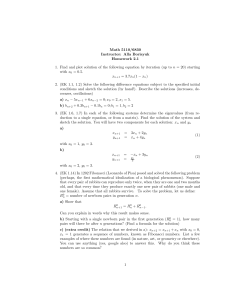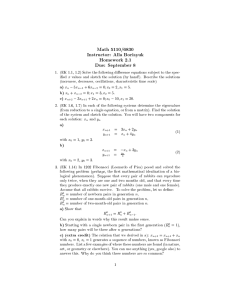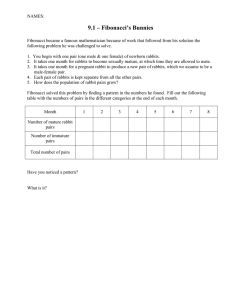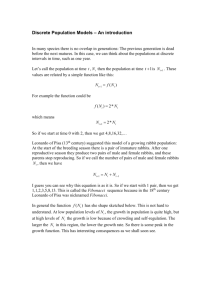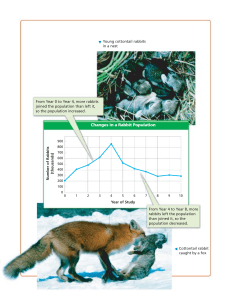Fibonacci Sequence: Rabbits and Flowers Worksheet
advertisement
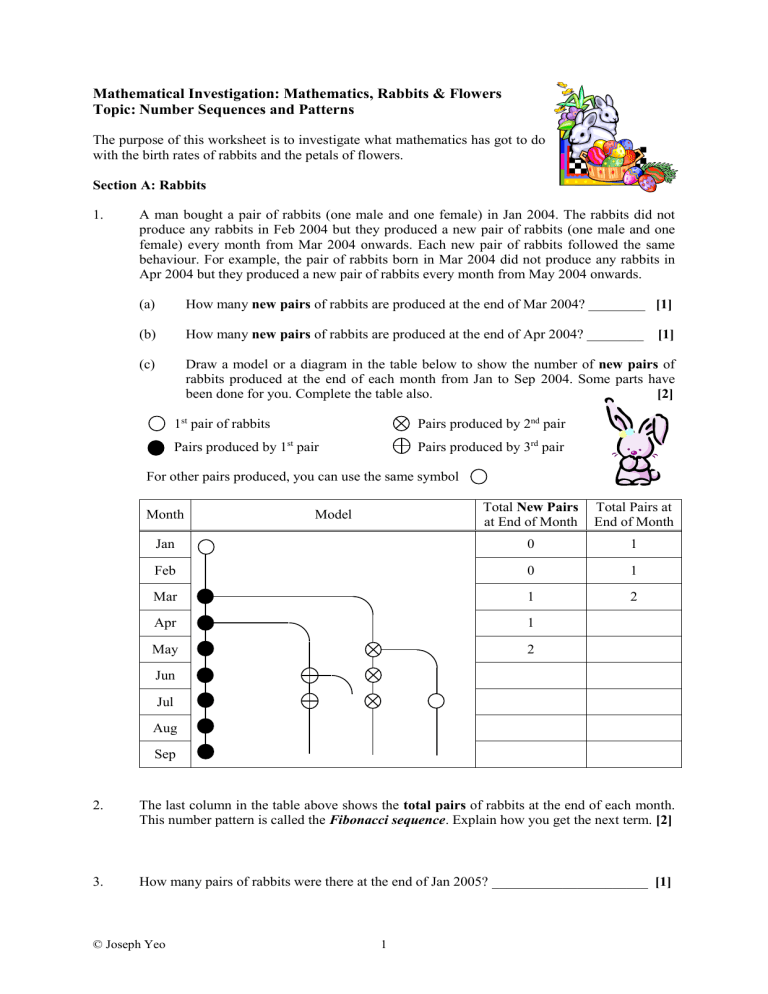
Mathematical Investigation: Mathematics, Rabbits & Flowers Topic: Number Sequences and Patterns The purpose of this worksheet is to investigate what mathematics has got to do with the birth rates of rabbits and the petals of flowers. Section A: Rabbits 1. A man bought a pair of rabbits (one male and one female) in Jan 2004. The rabbits did not produce any rabbits in Feb 2004 but they produced a new pair of rabbits (one male and one female) every month from Mar 2004 onwards. Each new pair of rabbits followed the same behaviour. For example, the pair of rabbits born in Mar 2004 did not produce any rabbits in Apr 2004 but they produced a new pair of rabbits every month from May 2004 onwards. (a) How many new pairs of rabbits are produced at the end of Mar 2004? ________ [1] (b) How many new pairs of rabbits are produced at the end of Apr 2004? ________ [1] (c) Draw a model or a diagram in the table below to show the number of new pairs of rabbits produced at the end of each month from Jan to Sep 2004. Some parts have been done for you. Complete the table also. [2] 1st pair of rabbits Pairs produced by 2nd pair Pairs produced by 1st pair Pairs produced by 3rd pair For other pairs produced, you can use the same symbol Total New Pairs at End of Month Total Pairs at End of Month Jan 0 1 Feb 0 1 Mar 1 2 Apr 1 May 2 Month Model Jun Jul Aug Sep 2. The last column in the table above shows the total pairs of rabbits at the end of each month. This number pattern is called the Fibonacci sequence. Explain how you get the next term. [2] 3. How many pairs of rabbits were there at the end of Jan 2005? ______________________ [1] © Joseph Yeo 1 Section B: Flowers 4. 5. 1 Write down the number of petals1 for each flower below. [1] Picture A: White Calla Lily Picture B: Euphorbia Picture C: Waterplantain Picture D: White Vinca Picture E: Moonbeam Coreopsis Picture F: Orange Zinnia What do you notice about these numbers? [1] For botanists, some of these so-called ‘petals’ are actually sepals or bracts. But laymen like you and me would not be able to differentiate between them. So the term ‘petals’ here refers to what we laymen normally would call ‘petals’. © Joseph Yeo 2 6. 7. However there are exceptions. Write down the number of petals for each flower below. Picture G: Ixora Picture H: Daylily Picture I: Starflower Picture J: Passion Flower [1] One type of exception is that the number of petals follows the Lucas Sequence. The Lucas Sequence is just like the Fibonacci Sequence except that the starting two numbers are 2 and 1, instead of 1 and 1. Write down the next 5 terms in the Lucas Sequence below: 2, 1, 3, ______ , ______ , ______ , ______ , ______ , … [1] 8. Write down the first 3 numbers in the Lucas Sequence that are not Fibonacci numbers. [1] 9. Compare your answers in Q6 and Q8. Which flowers are still exceptions, i.e. their number of petals is not a Fibonacci or a Lucas number? Write down their number of petals also. [2] 10. The second type of exception is the doubling of petals from a Fibonacci number. Which Fibonacci numbers give rise to the exceptions in Q9? [1] 11. The third type of exception is due to mutants or hybrids created artificially. Nowadays roses come with many different petals because they have been created artificially. Make a guess how many petals a wild rose (i.e. not a hybrid) has. Or you can search the Internet for more information. Hint: It is a Fibonacci number. [1] © Joseph Yeo 3 12. Hence write down the numbers of petals a natural flower (excluding mutants) can have. Just list the first 10 numbers. [1] Further Investigation 13. One of the most important questions in any mathematical investigation that you should ask yourself is: “What else is there for me to investigate?” List one thing related to this topic that you would like to investigate further and investigate it. [2] Question: __________________________________________________________________ Answer: Conclusion 14. Write down one main lesson that you have learnt from this worksheet. Final Score: / 20 Final Score 16-20 13-15 10-12 7-9 0-6 Grade A B C D F Teacher’s Comments (if any): © Joseph Yeo [1] 4 © Joseph Yeo 5
